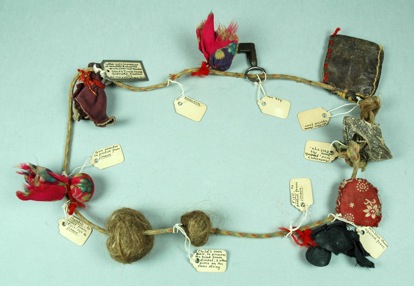Charm bandolier
Berber people, Algeria, c. 1919
 Collected by Melville William Hilton-Simpson before 1919, and purchased from him in 1920; 1920.42.25A Berber girl of the Aurès Mountains in eastern Algeria would have worn this sash or bandolier over her shoulder. Attached to it are ten charms designed to protect her from various negative or evil forces.
Collected by Melville William Hilton-Simpson before 1919, and purchased from him in 1920; 1920.42.25A Berber girl of the Aurès Mountains in eastern Algeria would have worn this sash or bandolier over her shoulder. Attached to it are ten charms designed to protect her from various negative or evil forces.
Some of the charms are to ward off ill health. The leather packet, shown here in the top right corner, contains a charm written in Arabic on paper to protect against fever. The bundles of hair, made from the child's own hair, are likewise intended to protect the head from disease.
There are several fabric bundles containing gunpowder, a pungent plant extract called 'devil's dung' (asafoetida), and other substances believed to protect against jinn – mischievous spirits and source of the word 'genie'. Gunpowder contains saltpetre which has long been spinkled into baths and shoes to protect against evil. Asafoetida too is not limited to use in the Arabic world; in Jamaica it is traditionally applied to an infant's fontanelle ('soft spot') to prevent bad spirits entering through there.
The iron key at the top and the scaly chameleon's head to the right are both intended to protect against the Evil Eye. The Evil Eye is the power attributed to some people who are thought to be able to exert an evil influence on someone else just by looking at them. It is often associated with jealousy and malice and can bring disaster, malady or even death upon the targeted person or their family. Belief in the Evil Eye is historically centred around southern Mediterranean, Middle Eastern and North African cultures and for thousands of years people have used charms on their person or in their home against it. These usually take the form of distinctively shaped or coloured objects that might distract the Eye's attention away from the wearer into the charm.
The key was one of many symbols adopted from Europe as a charm. Along with the frog, crescent moon and rue sprig, it was a protective symbol associated with the classical goddess Diana, whose cult was centred in Naples, Italy. The key relates to Diana's role as keeper of the gates of heaven and the portals of light and dark.
The insect-eating chameleon, although harmless to humans, is believed to possess magical powers to the Berber people. For example, a cheated wife may conceal chameleon meat or bones in her wayward husband's meals in order to restore his fidelity. Dried chameleons can still be found at Moroccan and Algerian markets to buy as protective charms for people or livestock.
